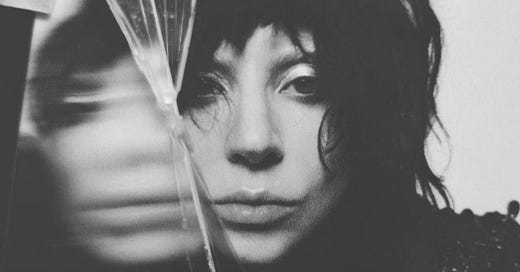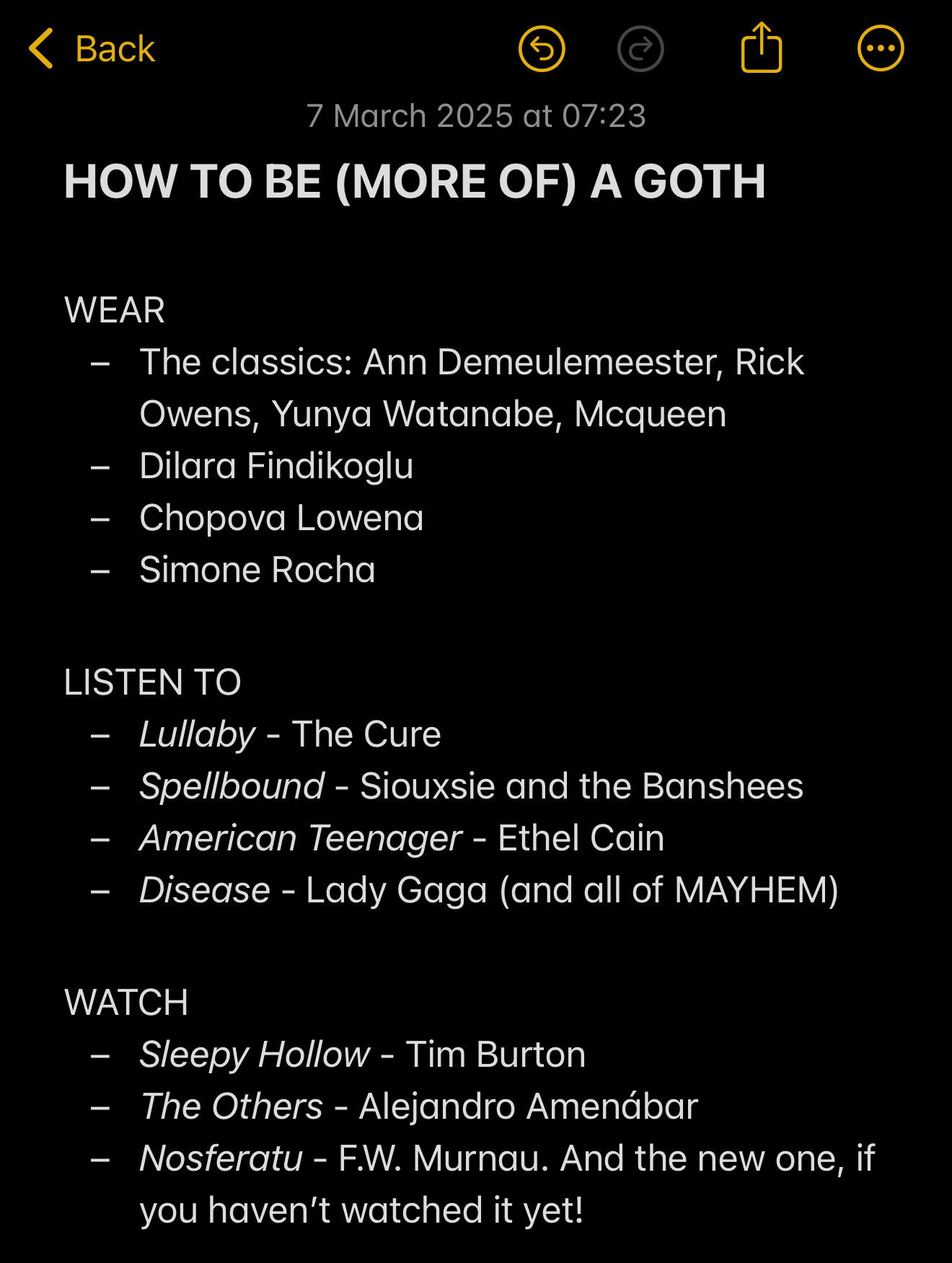A Gothic MAYHEM
As Lady Gaga’s new dark pop album crashes onto the world, let’s delve into the resurgence of Gothic aesthetics in culture and the deeper meaning behind it.
WHAT’S HAPPENING. The Return of Gothic Aesthetics
Gothic and dark aesthetics have crept back into fashion, music, film, and pop culture: no longer confined to the shadows, but spreading far beyond their usual enclaves.
Fashion: A Darker Turn Across the Industry
Some fashion brands have long embraced dark aesthetics, including the ‘Lord of Darkness’ Rick Owens, Alexander McQueen, and Ann Demeulemeester, all drawing from dystopian, Gothic, and Victorian influences.
Over the past year, however, these influences have well transcended their niche. Prada’s recent Fall/Winter collections have been dominated by black and somber palettes, while their Spring/Summer 2025 incorporated punk elements and bold leather pieces. Alessandro Michele’s debut at Valentino for Spring/Summer 2025, followed by his Couture show, also featured plenty of Victorian ruffles, high collars, and gothic-inspired gowns. Since its Cruise 2025 collection in Scotland, Dior has embarked on a darker trajectory, paying homage to Mary, Queen of Scots with tartan, medieval puff sleeves, and intricate lace - an evolution that continuity in its Couture show, where Alice in Wonderland was reimagined through a punk-goth lens. The culmination of this movement came in January with Jean Paul Gaulthier’s collection by Ludovic de Saint Sernin, which took us on a shipwreck journey featuring dark mermaids and Amelia Gray as a frighteningly seductive sea monster.
While this dark era might seem like another turn of the fashion cycle, which resuscitates past trends every twenty years, this shift feels more profound, as it stretches far beyond the runway.
Film: Horror and Gothic’s Dominance in the Mainstream
The horror genre has made a formidable comeback, doubling its market share over the past decades, proving an increasingly mainstream popularity. Beyond the commercial success of the genre, 2024 has also seen an explosion of critically acclaimed horror movies: Beetlejuice 2 and Nosferatu presented classic horror themes laced with heavily Victorian aesthetics, while The Substance and Longlegs delved into body horror and the darkness of evil in contemporary settings.
Victorian aesthetics have also permeated movies outside the horror genre, with Poor Things standing as a prime example. This quasi-Frankenstein narrative weaves together themes of mortality, rebirth, and self-discovery, with the film’s striking costumes serving as a visual representation of its darkly surreal coming-of-age tale about freedom and identity.
Music: A Sonic Dark Wave
Today, Lady Gaga’s MAYHEM release marks a pivotal moment in music’s darker direction, as she dives into her inner conflicts and vulnerabilities, blending pop and gothic aesthetics. But she’s not alone, as this gothic revival is a key trend across the industry.
After 16 years, The Cure returned at the end of 2024 with Songs of a Lost World, proving that their influence on goth music remains as strong as ever. As one of the genre’s founding bands alongside Bauhaus, Joy Division, and Siouxsie and the Banshees, The Cure helped shape the melancholic, introspective, and eerie sound that defined goth music in the 1980s. Their resurgence is not just nostalgic; it’s a sign of goth’s lasting cultural weight.
Meanwhile, a new wave of artists is carrying these themes forward. Ethel Cain has surged popularity, marking over 1 million Spotify streams in a day on November 1st, 2024. Her music takes listeners to haunting Southern Gothic landscapes, where melancholic, eerie, and religiously haunted themes intertwine.
WHY YOU SHOULD CARE. The Meaning Behind the Darkness
This recent surge of dark aesthetics across culture is more than a passing trend driven by a few fashion shows or the red carpet looks of figures like Jenna Ortega and Gabbriette; instead, two central ideas emerge to explain this cultural shift: horror as a tool for catharsis, and as a response to conflict, both cultural and existential.
In the early 2010s, psychologist Paul Rozin introduced the concept of benign masochism, which explains why people are drawn to intentionally unsettling or uncomfortable experiences - ranging from horror and tragic stories to even spicy food - as a way to confront negative emotions in a controlled environment. According to this theory, horror provides a safe space to engage with fear, mortality, and darkness, allowing individuals to explore and process these emotions without real-world danger.
Whether through fashion, film, or music, people are increasingly drawn to dark and Gothic aesthetics - and the macabre themes they evoke - as a means of processing negative emotions. In today’s uncertain world, marked by political conflict, economic instability, and the looming threat of climate change, these themes offer an outlet for confronting and expressing the anxieties that define our time.
This takes us to the second point: the Gothic aesthetic as a powerful vehicle for confronting the tumultuous world around us. Dark fiction has consistently flourished during moments of social upheaval. In Jacobean England, plays like Macbeth and King Lear use bloodshed and the supernatural to explore fears of treachery and the instability of power, fueled by the influence of Machiavellian thought. During the Industrial Revolution and the Victorian Era, novels such as Dr. Jekyll and Mr Hyde confronted the fear of losing control over one’s darker instincts, reflecting the growing anxieties around scientific progress and the limits of human nature. The Great Depression birthed Gothic masterpieces such as Frankenstein and Dracula, dealing with the themes of poverty, death, and alienation.
Literary scholar James Watt delves into this very relationship between Gothic literature and social and cultural conflict, showing how Gothic fiction often emerges in response to moments of ideological uncertainty, power struggles, and shifting cultural values. From the emergence of the Gothic novel in the 18th century - where supernatural horror clashed with Enlightenment rationality - to its revival in today’s world of global unrest, Gothic narratives have continuously served as a mirror to society’s collective fears. Ultimately, Gothic culture is not simply about aesthetics or fiction: it’s about confrontation. It invites us to face the parts of ourselves we often prefer to ignore, offering a space to process fear, grief, and chaos. Reflecting on her song Disease, Lady Gaga described it as ‘facing myself and my inner darkness, and realising that sometimes I can’t win or escape the parts of myself that scare me’. Gothic art, in all its forms, beckons us to do the same: not to be swallowed by darkness, but to understand it and come to terms with it. And perhaps, in doing so, to find catharsis.









This essay got a mention here: https://mutantfutures.substack.com/p/006 😊
I love this! Your point about Gothic aesthetics providing catharsis really resonates with me. I’ve always loved horror movies and have always been an anxious person, and one of the main reasons I enjoy them is that they let me experience my anxiety in a safe and even twistedly enjoyable way.